Introduction
Galinsoga (Galinsoga quadriradiata) is an erect (upright), herbaceous, short-lived warm-season annual weed in Florida landscapes, container nurseries, and other agricultural production systems (Figure 1). In nurseries and landscapes, galinsoga can be a troublesome weed, but it has been utilized by some cultures for food or medicinal purposes (Nafici 2016). This article is written for green-industry professionals and others to aid in the identification and management of galinsoga in and around ornamental plants.
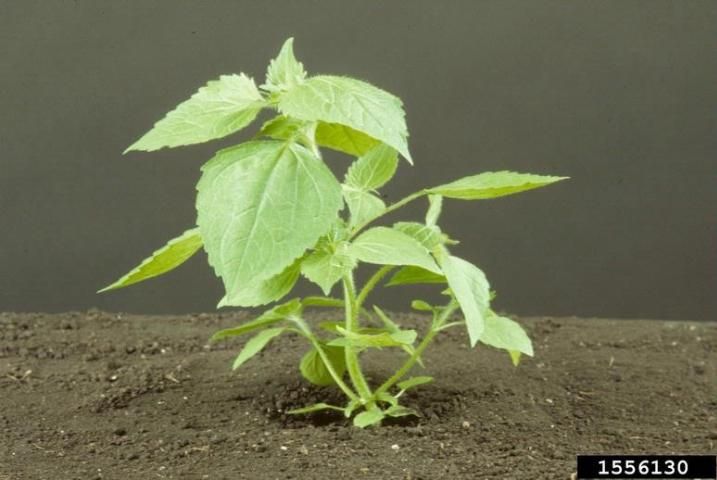
Credit: Ohio State Weed Lab, The Ohio State University, Bugwood.org
Species Description
Class
Dicotyledon
Family
Asteraceae (Aster family)
Other Common Names
Peruvian daisy, shaggysoldier, hairy galinsoga
Life Span
Warm-season annual
Habitat
Galinsoga is a common weed in agricultural fields, container-grown ornamentals, landscape planting beds, lawns, gardens, and other disturbed areas. In container nurseries, galinsoga can be found in containers, in pot drain holes, growing through weed mats, and in noncrop areas around the nursery. In landscapes, it is frequently found growing in turfgrass or in mulched planting beds but is also commonly found in cracks in sidewalks and between patio pavers. Galinsoga has a strong competitive advantage in high-light environments and prefers warm and sunny locations (Damalas 2008).
Distribution
Galinsoga is native to Central and South America. Due to its highly invasive potential, galinsoga has naturalized throughout the Americas, Europe, and Africa and is considered invasive in at least 40 countries (Rajas-Sandoval and Acevedo-Rodriguez 2014). In Florida, galinsoga is found throughout the state, but it is more commonly a nuisance in central and south Florida (Wunderlin et al. 2020).
Growth Habit
Stems are upright and reach 8 to 32 inches in height. Plants grow and mature quickly and can seed multiple generations per growing season (Rajas-Sandoval and Acevedo-Rodriguez 2014).
Seedling
Seedlings are erect with round cotyledons and a multibranched stem. Stems are usually sparsely hairy (Warwick and Sweet 1983) (Figure 2). Seedling germination is highest during the spring and throughout summer and early fall, from March to October. In field soils, germination is common after the soil is disturbed (tillage, planting, etc.), but seeds germinate readily in nursery potting soils. In warmer regions of central and south Florida, germination may occur year-round. Germination can occur between 50°F and 95°F and tends to increase as light increases, indicating that it readily germinates on the soil surface (Damalas 2008).
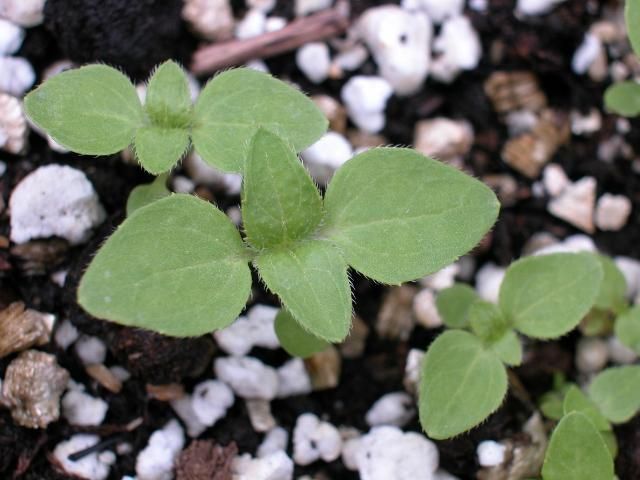
Credit: Annette Chandler, UF/IFAS
Shoots
Stems emerge from a shallow, fibrous root system. Leaves are simple, oppositely arranged, and narrow to oblong, and they have a pointed tip (Figure 3). Leaf margins are described as crenulate, meaning that they have small, rounded teeth or serrations. Leafs are 0.4 to 4.3 inches long and 0.2 to 1.6 inches wide (Warwick and Sweet 1983). On the lower region of stems, leaves have a petiole connecting the leafblade and stem. Leaves on the upper regions of the stems, however, are without a petiole (sessile) (Rajas-Sandoval and Acevedo-Rodriguez 2014).
Roots
Galinsoga has a shallow and somewhat fibrous root system. It does not form rhizomes.
Inflorescence
The inflorescence, or flower, is typical of plants in Asteraceae (sunflower or daisy family). What is typically described as being a single flower on plants in this family is actually a cluster of many small flowers grouped together in a flower head. In galinsoga, the white "petals" are ray flowers. There are five of these white ray flowers, which have three "teeth" at the tip of the ray. The center of the flower head is yellow and is comprised of many disc flowers. The entire flower head (ray and disc flowers) measures 0.2 to 0.3 inches in diameter, and several hundred flower heads can form on a mature galinsoga plant (Rajas-Sandoval and Acevedo-Rodriguez 2014; Damalas 2008) (Figure 3).
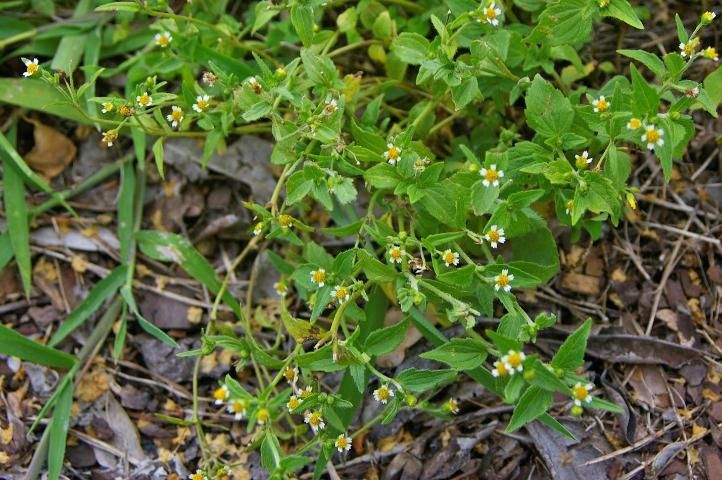
Credit: Annette Chandler, UF/IFAS
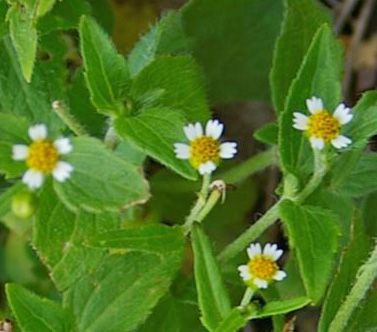
Credit: Annette Chandler, UF/IFAS
Fruit and Seeds
Fruit are achenes (dry, one-seeded fruit). Seeds are black and 1 to 1.5 mm long. Seeds can remain viable for more than 2 years and are the primary mechanism of galinsoga spread. Seeds are easily transported by wind and water (Dalamas 2008).
Similar Species
While there are 14 species of Galinsoga worldwide (Rajas-Sandoval and Acevedo-Rodriguez 2014), the two most common species of Galinsoga found in nurseries are G. quadriradiata and G. parviflora (small-flower galinsoga). Currently, only G. quadriradiata is documented in Florida (Wunderlin 2020). Both species are summer annuals and can be troublesome weeds in landscapes or container ornamentals. The primary difference between the two species is that G. parviflora has fewer hairs (pubescence) on its stems and leaves compared with G. quadriradiata (Dalamas 2008; Warwick and Sweet 1983).
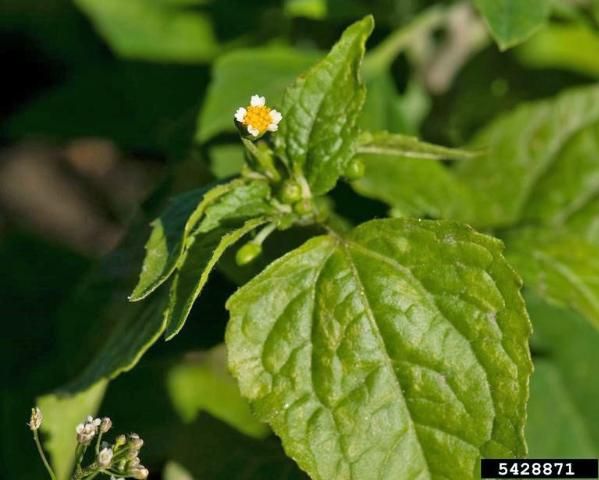
Credit: Bonsak Hammeraas, The Norwegian Institute of Bioeconomy Research, Bugwood.org
Plant Biology
Galinsoga is one of the most troublesome weeds of nurseries and landscapes in many parts of the world. It is fast growing and can produce up to 7,500 seeds within only 8 to 9 weeks after germination (Kagima 2000). After seeds mature on the plant, they are immediately viable and can begin to germinate and grow after making contact with the soil, which leads to multiple generations per season (Damalas 2008).
Management
Physical and Cultural Control
Due to limited herbicide options, prevention of weed establishment is the most successful method of management for galinsoga and most other weed species in container nurseries and landscapes. Scout and monitor fields regularly and hand-weed escaped seedlings before flowering occurs. Because galinsoga can regrow after being cut, ensure that roots are removed and plants are not simply clipped during weeding. Research has shown that galinsoga germination is significantly reduced as planting depth increases (Cauwer et al. 2013). Therefore, application of mulch may prevent or reduce establishment and spread. In nursery containers, mulch such as pine bark nuggets, rice hulls, or wood chips can be applied at depths of 1 to 2 inches. In landscapes, pine bark nuggets, pine straw, or other materials can be applied at depths from 2 to 4 inches. Mowing and tillage have not been effective long-term strategies for galinsoga because plants can tolerate mowing, and tillage may increase germination due to soil disturbance (Damalas 2008).
Chemical Control
Most nonselective postemergence herbicides labeled for use in nurseries and landscapes control galinsoga. In noncrop areas or planting beds, nonselective systemic (translocated) herbicides such as glyphosate can be used. Smaller galinsoga may be controlled by nonselective contact herbicides, such as glufosinate (Finale), diquat (Reward), or pelargonic acid (Scythe), but repeated applications may be needed for larger plants.
Many broad-spectrum preemergence herbicides can be used for galinsoga control. Herbicides such as flumioxazin (Broadstar or SureGuard), dimethenamid-P + pendimethalin (FreeHand), and isoxaben (Gallery) have been shown to be effective for galinsoga control and are labeled for use in nurseries or in landscape planting beds. A complete list of preemergence herbicide options, including the use sites where the herbicides are registered, is included in Table 1.
References
Cauwer, B. D., R. Devos, S. Claerhout, R. Bulcke, and D. Reheul. 2013. "Seed Dormancy, Germination, Emergence, and Seed Longevity in Galinsoga parviflora and G. quadriradiata." Weed Res. 54:38–47.
Damalas, C. 2008. "Distribution, Biology, and Agricultural Importance of Galinsoga parviflora (Asteraceae)." Weed Biology and Management 8 (3): 147–153. https://doi.org/10.1111/j.1445-6664.2008.00290.x
Kagima, D. 2000. "Bibliography and Biology of Galinsoga spp." Ames, IA: The ISU Weed Biology Library, Iowa State University.
Nafici, S. 2016. "Weed of the Month: Galinsoga." Urban Gardening and Ecology Garden News Blog. Brooklyn Botanical Gardens. Accessed 18 Feb. 2020. https://www.bbg.org/news/weed_of_the_month_galinsoga
Rojas-Sandoval, J., and P. Acevedo-Rodriguez. 2014. "Galinsoga quadriradiata (Shaggy Soldier) Datasheet." CAB International. Accessed 16 Mar. 2020. https://www.cabi.org/isc/datasheet/120145
USDA, NRCS. 2020. The PLANTS Database. Accessed 20 Feb. 2020. https://plants.usda.gov/core/profile?symbol=GAPA2
Warwick, S., and R. Sweet. 1983. "The Biology of Canadian Weeds. 58. Galinsoga parviflora and G. quadriradiata." Canadian Journal of Plant Science 63:695–709. Accessed 18 Feb. 2020. https://doi.org/10.4141/cjps83-087
Wunderlin, R. P., B. F. Hansen, R. Franck, and F. B. Essig. 2020. "Atlas of Florida Plants." Accessed 4 Mar. 2020. http://florida.plantatlas.usf.edu
Preemergence herbicides labeled for use in nursery production and landscape planting beds for the control of galinsoga. This table lists registered pesticides that should be integrated with other pest management methods. Additional information on integrated pest management methods can be requested from UF/IFAS Extension horticulture or agriculture agents. A list of local UF/IFAS Extension offices is available at https://sfyl.ifas.ufl.edu/find-your-local-office/.